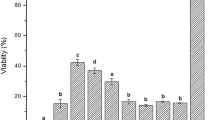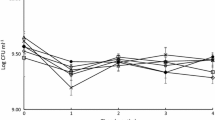Abstract
The effect of the microencapsulation by spray drying of the biocontrol agent Meyerozyma guilliermondii was evaluated by isothermal microcalorimetry (IMC) and traditional microbiological methods. The concentration of wall materials (soy protein isolate and sodium alginate) and inlet air temperature of the spray dryer were evaluated on the yeast viability, release rate and inhibition of Colletotrichum gloeosporioides. The parameters obtained by IMC such as maximum growth rate, lag phase time, total heat produced and the time to peak obtained from the heat flow curves were also analysed. The results showed an effect of the inlet air temperature and SPI concentration on the patterns of the heat flow curves vs. time, as well as in the kinetic parameters obtained from them. An inversely proportional correlation was found between the lag phase time and the parameters of release rate and percentage of mycelial growth inhibition. The total heat produced and the maximum growth rate was correlated with the percentage of inhibition. Likewise, the total heat produced was also correlated with the release rate. In this study, we found that higher activity of the yeast (measured in terms of heat produced and maximum growth rate by IMC) indicates a higher antifungal activity against C. gloeosporioides.





Similar content being viewed by others
Availability of data and materials
Not applicable.
Code availability
Not applicable.
References
Spadaro D, Droby S. Development of biocontrol products for postharvest diseases of fruit: the importance of elucidating the mechanisms of action of yeast antagonists. Trends Food Sci Technol. 2016;47:39–49. https://doi.org/10.1016/j.tifs.2015.11.003.
Marín A, Atarés L, Chiralt A. Improving function of biocontrol agents incorporated in antifungal fruit coatings: a review. Biocontrol Sci Technol. 2017;27(10):1220–41. https://doi.org/10.1080/09583157.2017.1390068.
Droby S, Wisniewski M, Teixidó N, Spadaro D, Jijakli MH. The science, development, and commercialization of postharvest biocontrol products. Postharvest Biol Technol. 2016;122(2015):22–9. https://doi.org/10.1016/j.postharvbio.2016.04.006.
Sharma RR, Singh D, Singh R. Biological control of postharvest diseases of fruits and vegetables by microbial antagonists: a review. Biol Control. 2009;50(3):205–21. https://doi.org/10.1016/j.biocontrol.2009.05.001.
Ma X, Wang X, Cheng J, Nie X, Yu X, Zhao Y, et al. Microencapsulation of Bacillus subtilis B99-2 and its biocontrol efficiency against Rhizoctonia solani in tomato. Biol Control. 2015;90:34–41. https://doi.org/10.1016/j.biocontrol.2015.05.013.
Vemmer M, Patel AV. Review of encapsulation methods suitable for microbial biological control agents. Biol Control. 2013;67(3):380–9. https://doi.org/10.1016/j.biocontrol.2013.09.003.
Aguirre-Güitrón L, Calderón-Santoyo M, Ortiz-Basurto RI, Bautista-Rosales PU, Ragazzo-Sánchez JA. Optimisation of the spray drying process of formulating the post-harvest biocontrol agent Meyerozyma caribbica. Biocontrol Sci Technol. 2018;28(6):574–90.
Muñoz-Celaya AL, Ortiz-García M, Vernon-Carter EJ, Jauregui-Rincón J, Galindo E, Serrano-Carreón L. Spray-drying microencapsulation of Trichoderma harzianum conidias in carbohydrate polymers matrices. Carbohydr Polym. 2012;88(4):1141–8.
Aguirre-Güitrón L, Calderón-Santoyo M, Lagarón JM, Prieto C, Ragazzo-Sánchez JA. Formulation of the biological control yeast Meyerozyma caribbica by electrospraying process: effect on postharvest control of anthracnose in mango (Mangifera indica L.) and papaya (Carica papaya L.). J Sci Food Agric. 2022;102(2):696–706. https://doi.org/10.1002/jsfa.11400.
Kim IY, Pusey PL, Zhao Y, Korban SS, Choi H, Kim KK. Controlled release of Pantoea agglomerans E325 for biocontrol of fire blight disease of apple. J Control Release. 2012;161(1):109–15. https://doi.org/10.1016/j.jconrel.2012.03.028.
Covarrubias-Rivera L, López-Cruz R, Ragazzo-Sánchez JA, Iñiguez-Moreno M, Calderón-Santoyo M. Determination by isothermal microcalorimetry of the sensitivity of phytopathogenic fungi of tropical fruits against an ethanolic extract of jackfruit leaf (Artocarpus heterophyllus Lam.). J Microbiol Methods. 2022;195:106457. https://doi.org/10.1016/j.mimet.2022.106457.
Fredua-Agyeman M, Gaisford S, Beezer AE. Observation with microcalorimetry: behaviour of P. aeruginosa in mixed cultures with S. aureus and E. coli. Thermochim Acta. 2018;663:93–8. https://doi.org/10.1016/j.tca.2018.03.009.
Fredua-Agyeman M, Stapleton P, Basit AW, Beezer AE, Gaisford S. In vitro inhibition of Clostridium difficile by commercial probiotics: a microcalorimetric study. Int J Pharm. 2017;517(1–2):96–103. https://doi.org/10.1016/j.ijpharm.2016.12.005.
Nykyri J, Herrmann AM, Håkansson S. Isothermal microcalorimetry for thermal viable count of microorganisms in pure cultures and stabilized formulations. BMC Microbiol. 2019. https://doi.org/10.1186/s12866-019-1432-8.
Braissant O, Bachmann A, Bonkat G. Microcalorimetric assays for measuring cell growth and metabolic activity: methodology and applications. Methods. 2015;76:27–34. https://doi.org/10.1016/j.ymeth.2014.10.009.
Bricheux G, Bonnet JL, Bohatier J, Morel JP, Morel-Desrosiers N. Microcalorimetry: a powerful and original tool for tracking the toxicity of a xenobiotic on Tetrahymena pyriformis. Ecotoxicol Environ Saf. 2013;98:88–94. https://doi.org/10.1016/j.ecoenv.2013.09.019.
Wadsö I. Characterization of microbial activity in soil by use of isothermal microcalorimetry. J Therm Anal Calorim. 2009;95(3):843–50.
Rong X-M, Huang Q-Y, Jiang D-H, Cai P, Liang W. Isothermal microcalorimetry: a review of applications in soil and environmental sciences. Pedosphere. 2007;17(2):137–45.
Braissant O, Bonkat G, Wirz D, Bachmann A. Microbial growth and isothermal microcalorimetry: growth models and their application to microcalorimetric data. Thermochim Acta. 2013;555:64–71. https://doi.org/10.1016/j.tca.2012.12.005.
Corte L, di Cagno R, Groenewald M, Roscini L, Colabella C, Gobbetti M, et al. Phenotypic and molecular diversity of Meyerozyma guilliermondii strains isolated from food and other environmental niches, hints for an incipient speciation. Food Microbiol. 2015;48:206–15. https://doi.org/10.1016/j.fm.2014.12.014.
de Lima JR, Viana FMP, Lima FA, Pieniz V, Gonçalves LRB. Efficiency of a yeast-based formulation for the biocontrol of postharvest anthracnose of papayas. Summa Phytopathol. 2014;40(3):203–11.
Coda R, Rizzello CG, Di Cagno R, Trani A, Cardinali G, Gobbetti M. Antifungal activity of Meyerozyma guilliermondii: identification of active compounds synthesized during dough fermentation and their effect on long-term storage of wheat bread. Food Microbiol. 2013;33(2):243–51. https://doi.org/10.1016/j.fm.2012.09.023.
Nantawanit N, Chanchaichaovivat A, Panijpan B, Ruenwongsa P. Induction of defense response against Colletotrichum capsici in chili fruit by the yeast Pichia guilliermondii strain R13. Biol Control. 2010;52(2):145–52. https://doi.org/10.1016/j.biocontrol.2009.10.011.
López-Cruz R, Ragazzo-Sánchez JA, Calderón-Santoyo M. Microencapsulation of Meyerozyma guilliermondii by spray drying using sodium alginate and soy protein isolate as wall materials: a biocontrol formulation for anthracnose disease of mango. Biocontrol Sci Technol. 2020;30(10):1116–32. https://doi.org/10.1080/09583157.2020.1793910.
Zwietering MH, Jongenburger I, Rombouts FM, Van’t Riet K. Modeling of the bacterial growth curve. Appl Environ Microbiol. 1990;56(6):1875–81.
R Core Team. R: a language and environment for statistical computing. R foundation for statistical computing. 2021. https://www.R-project.org/.
Tang Z, Huang X, Baxi S, Chambers JR, Sabour PM, Wang Q. Whey protein improves survival and release characteristics of bacteriophage Felix O1 encapsulated in alginate microspheres. Food Res Int. 2013;52(2):460–6. https://doi.org/10.1016/j.foodres.2012.12.037.
Dos Santos RCS, Finkler L, Finkler CLL. Microencapsulation of Lactobacillus casei by spray drying. J Microencapsul. 2014;31(8):759–67.
Arslan S, Erbas M, Tontul I, Topuz A. Microencapsulation of probiotic Saccharomyces cerevisiae var: Boulardii with different wall materials by spray drying. LWT Food Sci Technol. 2015;63(1):685–90. https://doi.org/10.1016/j.lwt.2015.03.034.
Duongthingoc D, George P, Katopo L, Gorczyca E, Kasapis S. Effect of whey protein agglomeration on spray dried microcapsules containing Saccharomyces boulardii. Food Chem. 2013;141(3):1782–8. https://doi.org/10.1016/j.foodchem.2013.04.093.
Garcia AH, Herrmann AM, Håkansson S. Isothermal microcalorimetry for rapid viability assessment of freeze-dried Lactobacillus reuteri. Process Biochem. 2017;55:49–54. https://doi.org/10.1016/j.procbio.2017.01.012.
Bonkat G, Braissant O, Widmer AF, Frei R, Rieken M, Wyler S, et al. Rapid detection of urinary tract pathogens using microcalorimetry: principle, technique and first results. BJU Int. 2012;110(6):892–7.
Acknowledgements
This study was financially supported by CONACYT (Mexico) whom the authors thank for the scholarship granted to Rafael López-Cruz (305354) and to the support through the project No. 316948, and Tecnologico Nacional de Mexico through the project No. 7868.20-P. This research is part of the activities of the CYTED network N319RT0576 “Desarrollo sostenible en agroalimentacion y aprovechamiento de residuos industriales”.
Funding
This study was financially supported by CONACYT (Mexico) whom the authors thank for the scholarship granted to Rafael López-Cruz (305354) and through the Project 316948, and Tecnologico Nacional de Mexico through the Project No. 7868.20-P. This research is part of the activities of the CYTED network N319RT0576 “Desarrollo sostenible en agroalimentacion y aprovechamiento de residuos industriales”.
Author information
Authors and Affiliations
Contributions
All authors contributed to the study conception and design. Material preparation, data collection and analysis were performed by RL-C. The first draft of the manuscript was written by RL-C and all authors commented on previous versions of the manuscript. All authors read and approved the final manuscript.
Corresponding author
Ethics declarations
Conflict of interest
The authors declare that they have no conflict of interest.
Ethics approval
Not applicable.
Consent to participate
Not applicable.
Consent for publication
The authors hereby declare that participated in the study and in the development of the manuscript, have read the final version and give consent for the article to be published in Journal of Thermal Analysis and Calorimetry.
Additional information
Publisher's Note
Springer Nature remains neutral with regard to jurisdictional claims in published maps and institutional affiliations.
Rights and permissions
About this article
Cite this article
López-Cruz, R., Ragazzo-Sánchez, J.A., Braissant, O. et al. Use of isothermal microcalorimetry to characterize the behavior of the microencapsulated biocontrol agent Meyerozyma guilliermondii. J Therm Anal Calorim 147, 12569–12576 (2022). https://doi.org/10.1007/s10973-022-11456-8
Received:
Accepted:
Published:
Issue Date:
DOI: https://doi.org/10.1007/s10973-022-11456-8




